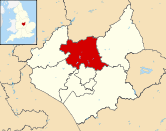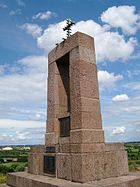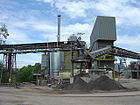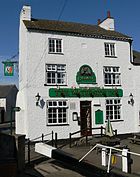- Mountsorrel
-
- For Mount Sorrel, Wiltshire, see Broad Chalke.
Coordinates: 52°43′00″N 1°09′00″W / 52.7167°N 1.15°W
Mountsorrel
The Butter Market
 Mountsorrel shown within Leicestershire
Mountsorrel shown within LeicestershirePopulation 6,662 (2001 Census)[1] - London 95 miles (153 km) SSE District Charnwood Shire county Leicestershire Region East Midlands Country England Sovereign state United Kingdom Post town LOUGHBOROUGH Postcode district LE12 Dialling code 0116 Police Leicestershire Fire Leicestershire Ambulance East Midlands EU Parliament East Midlands List of places: UK • England • Leicestershire Mountsorrel is a village in Leicestershire on the River Soar, just south of Loughborough with a population in 2001 of 6,662 inhabitants.[1][2]
Contents
Geography
The village is in the borough of Charnwood, surrounding a steep hill, once crowned by a castle, and is bordered to the east by the River Soar.
The village is renowned for the Buttercross Market in the village centre as well as its granite quarry, the largest in Europe. The Leicester arm of the Grand Union Canal runs through Mountsorrel.
The civil parish meets with Rothley to the south, and some houses are actually in Rothley parish near the southern A6 junction. To the west of the parish is a nature reserve. North of here the Leicestershire Round passes east-west through the north of the village. The parish boundary meets Quorndon where it first meets the quarry near Buddon Wood. North of there it crosses the former A6 500 metres towards Quorn from the roundabout for the A6 roundabout. Close to the bypass the River Soar becomes the parish boundary and south of the A6 northern junction it meets Sileby at the point where it crosses the A6 bypass. 500 metres south of there the boundary leaves the river to the west, with the river becoming the Sileby-Rothley boundary.
Geology
The local area is built on granite. Leicester's Humberstone came from this granite (igneous rock), and was originally known as Hunbeort's Stan. Another piece of Mountsorrel granite is at an RAF memorial at Screveton in Nottinghamshire near the A46.
History
Early history
A castle was built in 1080 by Hugh Lupus, but there is evidence of an earlier Norman settlement in the area in the form of pottery fragments. A Roman villa is supposed to have existed on Broad Hill during the 4th century AD, the site of today's quarry, as quarrying during the late 1800s revealed many artefacts including a preserved wooden bucket.[3] However, the first recording of the village was in 1377, when it had a population of 156.
In 1151, Robert le Bossu, the Earl of Leicester and deputy to Henry II of England, who was the Justicar, or Chief Justice of the Peace for the area, acquired the tenancy of Mountsorrel castle.
Whilst the origin of the name 'Mountsorrel' is still not understood fully, it is thought that the English nobility of the time named Mountsorrel after Montsoreau, a village in France close to Fontevrault, where Henry II was buried. The name Mountsorrel is of Norman-French origin and is thought to have developed due to the close likeness of Montsoreau and Mountsorrel – both settlements sit on rivers, the Loire and the Soar respectively, and are overshadowed by surrounding hills.[4][5]
Mountsorrel castle was used as a bastion against King Stephen, and was subsequently destroyed in 1217 by the King's men from Nottingham, branded a nest of the Devil and den of thieves and robbers.[3] King Louis VIII of France had sent support in the form of 20,000 men to the besieged barons in the castle, but this force had failed to arrive in time to prevent the razing to the ground of the castle. All that remains of the castle today is a granite crag on Castle Hill. The hill is also the site of a memorial (by Shirley Harrison, 1926) to those who lost their lives in World War I.[6]
One of the churches is dedicated to St. Peter.
Recent history
The village was also visited by Methodist preacher John Wesley, where he preached in a building which now belongs to Stonehurst Family Farm, a tourist attraction. By an act of Parliament passed on 22 July 1782 Henry Walkery of Thurmaston and John Sultzer of Burton Overy were empowered to enclose the open fields and common grounds of Mountsorrel, some 300 acres (1.2 km2). The Leicester Navigation was opened in 1794 and the first barges between Loughborough and Leicester departed on 26 October.
Mountsorrel was the site for a hospital for the mentally ill, which had 91 beds in 1979,[7] but this has since closed and been converted to a housing estate.
By 1871, the population was recorded as '150 dwellings',[3] and by 1840 the population of Mountsorrel had reached 1,900. During World War II, in 1942, Alvis, an armoured vehicle manufacturer based in Coventry, acquired a factory previously used to produce cardboard boxes in the village after their factory in Coventry was bombed by the Luftwaffe. Alvis built a new factory on the site of an old brickworks, which DeHavilland, an aeroplane propeller manufacturer, briefly used after the war until Rolls-Royce Limited acquired the site in 1945.
The A6 dual-carriageway Quorn-Mountsorrel Bypass opened in October 1991, allowing quarry traffic to avoid travelling through the village centre. On 31 July 2004 a new leisure centre opened in the village, the Soar Valley Leisure Centre. Christ Church & St Peters primary school is on Rothley Road.
The Butter Market
The Butter Market was built in 1793 by the Lord of the Manor, Sir John Danvers, to replace the fifteenth century Market Cross, which he had removed to use on his estate in Swithland, where it still remains.[6]
Industry and trade
Market
In 1292, Nicholas de Seagrave became Lord of the Manor and was granted by Edward I the right to hold a market in Mountsorrel each Monday. Seagrave's father, Stephen de Seagrave, was Chief Justice of England at the time, a position of great power, which may explain the granting of such a market.
In addition to the granting of the market, de Seagrave was permitted to hold an annual fair for the eve and morrow of St John the Baptist and 5 days after.[3] This fair was abolished in 1873 after villagers petitioned, as the legislation licensing the fair allowed anyone displaying a bush over their door to distribute liquor free of any duties.
By the eighteenth and nineteenth centuries, Mountsorrel market had become increasingly important, with trade in raw wool, leather and woollen yarn, horses and cattle as well as 'Mountsorrel gloves', once as highly regarded as gloves from Woodstock and Oxford, being common.
Quarry
As early as 1860, there was a branch line, the Mountsorrel Railway, to the quarry, the path of which is still followed by a mineral conveyor to Barrow-upon-Soar, where quarry rock is sorted for distribution. Organised quarrying of the granite in Mountsorrel Quarry began in the late eighteenth century, and had around 500 employees by 1870. In 1872, the Mountsorrel Granite Company acquired the rights to quarry the area from the Broad Hill quarry, and a hospital had become established in the village to deal with those made ill by the dust created by the quarrying.
Mountsorrel is home to one of the largest granite quarries in Europe, with an area of 785,400 m2.[8] The granite, technically horneblende granite, is primarily used in construction and road-repair. The quarry produces approximately 3 million tonnes per annum with reserves of 160 million tonnes of granite, making it one of the top ten largest producing quarries in Europe[9] in 1997. The quarry is blasted at 12.30 pm most weekdays,[10] with a force that is felt throughout most of the village, as well as in some parts of Quorn, Swithland, and Rothley.
The quarry was run by Redland Quarries until its acquisition by Lafarge in the 1990s. The quarry itself is home to the common lizard, an endangered species.[11]
Rolls-Royce
Rolls-Royce acquired a factory previously used by an aircraft propeller manufacturer after World War Two in 1945. The factory, officially known as 'Rolls-Royce Mountsorrel',[12] became a specialist production factory for 'structural and high temperature fabrications', advising on new designs of both aircraft and cars for Rolls-Royce.
In a fire during a heatwave on 13 May 1959, the manufacturing area of the factory was heavily damaged but the design department was left undamaged.
In 1969, the Mountsorrel Rolls-Royce factory designed and produced the RB211 engine for the Lockheed Tristar, and during the 1970s the factory employed 1,200 people, but it was shut in 1994 as production methods changed. The site has since been replaced by a housing estate.
Sporting Teams
- Mountsorrel Castle Cricket Club is a cricket club founded c.1880. It currently fields two teams in the ECB Everards Leicestershire Cricket League. Since 2006 the club has also fielded a Sunday friendly team.
Transport
The village is currently served by Arriva Fox County and Paul S Winson.
Paul S Winson service 99 Birstall – Mountsorrel[13]
Arriva 126/127 Leicester – Loughborough – Shepshed – Coalville[14]
Paul S Winson X27 – Loughborough – Quorn – Mountsorrel – Rothley[15]
Notable persons
- James Biddles, 19th century actor, his daughter Adelaide married Charles Alexander Calvert
- Rosemary Conley, the creator of the Hip & Thigh Diet, lived in Mountsorrel before moving to Quorndon.
- Hilda Lewis, daughter of the vicar William Lewis, married the palaeontologist Leslie Reginald Cox
- The sculptor John Charles Felix Rossi lived in the village in the 19th century
- Dick Turpin has a plaque, stating that it is believed locally that he used the mounting point opposite, The swan inn, Loughborough Road,

See also
References
- ^ a b http://www.leics.gov.uk/mountsorrel_ward.pdf
- ^ Local Communities in Charnwood http://www.charnwood.gov.uk/uploads/localcommunitiesincharnwood.pdf
- ^ a b c d mountsorrel.org.uk http://mountsorrel.org.uk/index.html
- ^ Dryden, Alice (1911) Memorials of Old Leicestershire, p. 117-8
- ^ Harper, Charles George (1924) The Manchester & Glasgow road: this way to Gretna Green, C. Palmer, p. 180
- ^ a b Pevsner, Nikolaus (1960) The Buildings of England: Leicestershire and Rutland, Penguin Books, p. 195, 247
- ^ Index of Lunatic Asylums and Mental Hospitals
- ^ LaFarge Aggregates, Mountsorrel Quarry http://www.lafargerail.com/mountsorrel/mountsorrel.html
- ^ The Quorndon Magazine http://www.quorndon-mag.org.uk/archive/autumn1997/redland.html
- ^ A Guide to Mountsorrel Quarry http://www.lafarge-aggregates.co.uk/LAF5883-LO-RES.pdf
- ^ Quarry Products Association http://www.qpa.org/env_bio.htm
- ^ mountsorrel.org.uk http://www.mountsorrel.org.uk/index.html
- ^ 99 Service areas http://www.winsoncoaches.co.uk/index.php?section=813
- ^ 126/127 Service times http://www.arrivabus.co.uk/serviceInformation.aspx?id=6121
- ^ X27 Service areas http://www.winsoncoaches.co.uk/index.php?section=813
External links
- Village website
- Mountsorrel Castle Cricket Club Official Site
- Mountsorrel Meadows
- Stonehurst Family Farm
Towns 
Large villages Anstey • Barrow upon Soar • Birstall • East Goscote • Mountsorrel • Quorn • Rothley • Sileby • Thurmaston
Small villages Barkby • Beeby • Burton on the Wolds • Cossington • Cropston • Hathern • Hoton • Newtown Linford • Queniborough • Ratcliffe on the Wreake • Rearsby • Seagrave • South Croxton • Swithland • Thrussington • Thurcaston • Ulverscroft • Walton on the Wolds • Wanlip • Woodhouse • Woodhouse Eaves • Wymeswold
Hamlets Categories:- Villages in Leicestershire
- Civil parishes in Leicestershire
- Charnwood
- Quarries in the United Kingdom
- Nature reserves in Leicestershire
Wikimedia Foundation. 2010.






